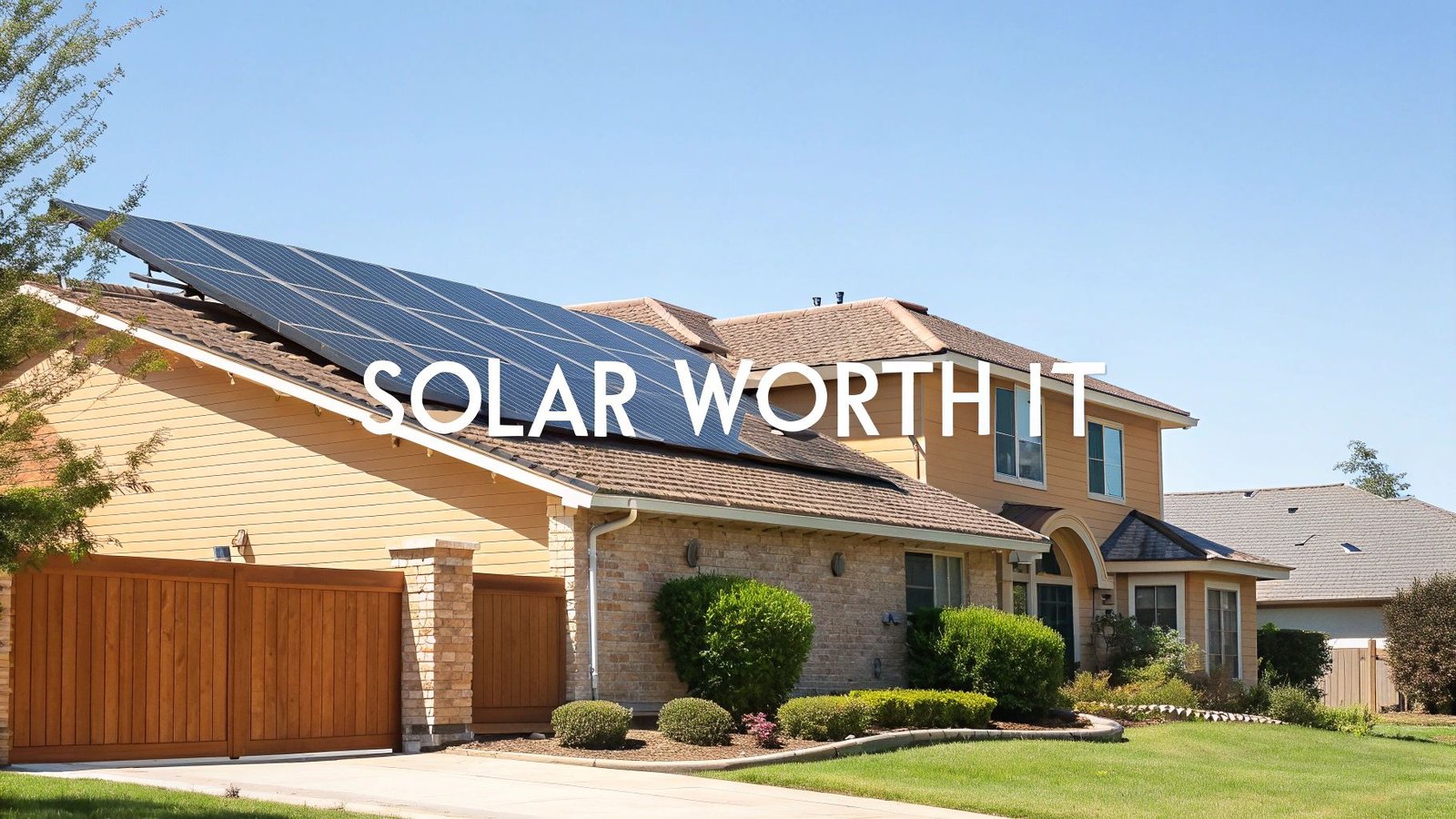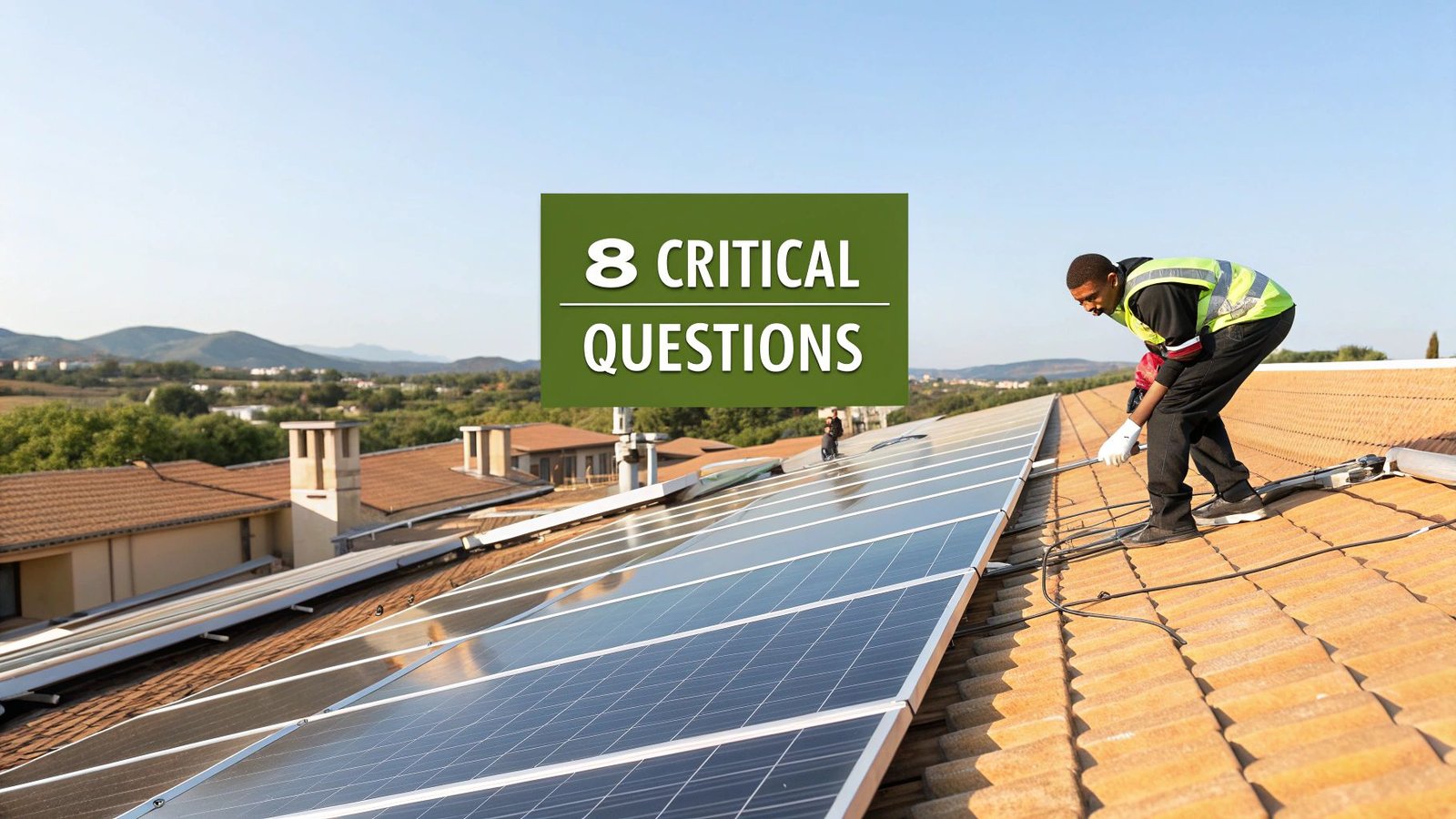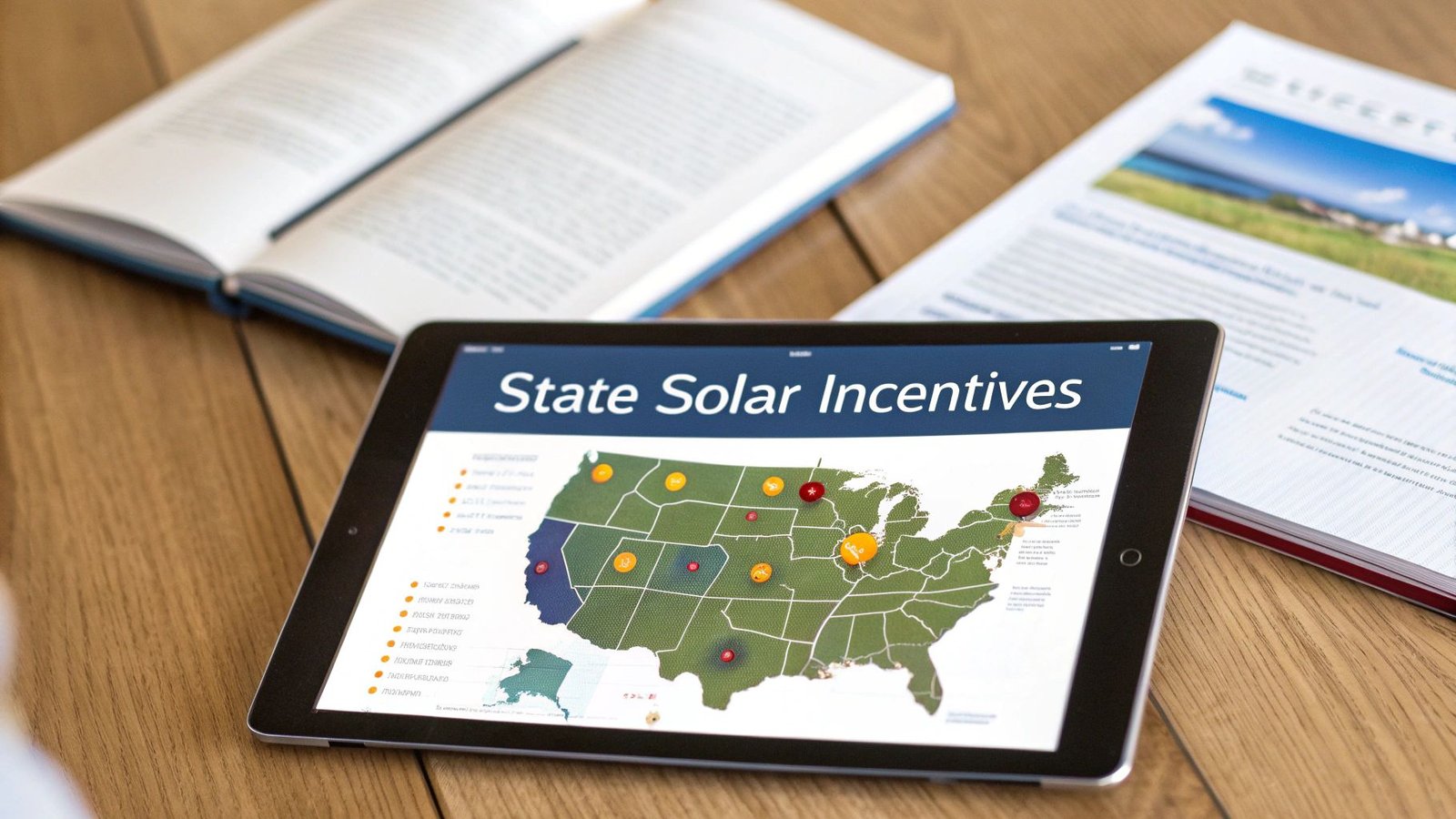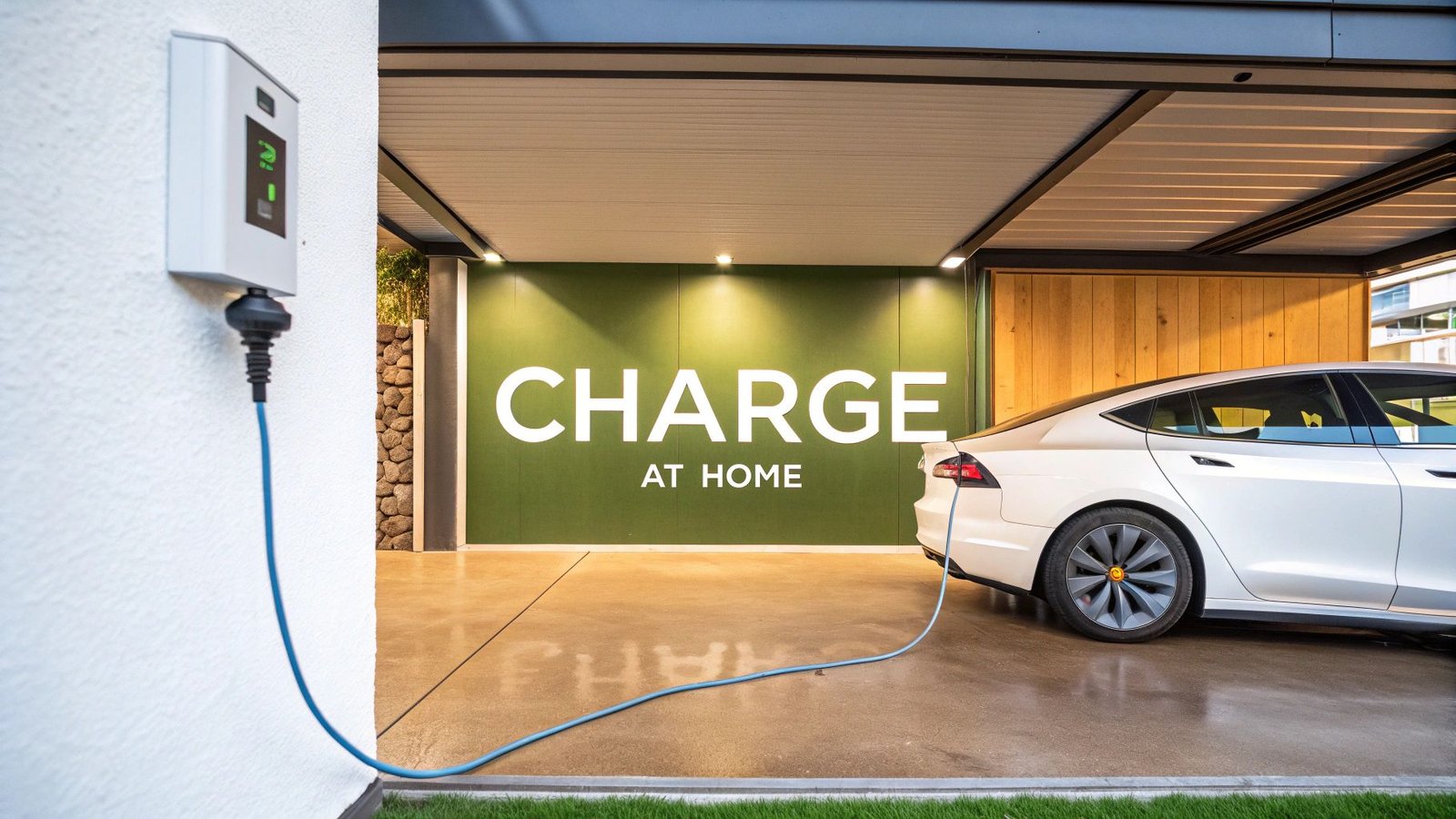For most homeowners, the answer to the big question—"is solar energy worth it?"—is a clear and confident yes. The best way to think about it isn't as just another home expense. It's more like prepaying for decades of your own electricity, but at a huge discount. This is especially true if you've got a decent amount of sun hitting your roof and you plan on staying in your home for the long haul.
Why Solar Is a Strong Financial Decision
Making the switch to solar is one of the smartest upgrades you can give your home, delivering financial perks right away and for many years to come. The real magic is in watching your monthly electricity bill shrink dramatically, or in some cases, disappear altogether. This puts you back in control, letting you lock in your energy costs for the future and shielding you from the constant, unpredictable rate hikes from the power company.
On top of the monthly savings, solar panels are a fantastic way to bump up your home's resale value. It's a feature that savvy homebuyers look for—who wouldn't want a home with lower running costs baked right in? When you add it all up, the financial argument for going solar is incredibly compelling.
The Numbers Behind the Savings
That initial price tag for a solar system can look a little intimidating at first, but when you factor in the available incentives and the long-term savings, the story changes completely.
A typical residential solar system might run anywhere from $10,290 to $20,580. But right off the bat, a 30% federal tax credit (available through 2032) can slice a huge chunk off that initial cost. Once your system is up and running, you can expect it to cut your household energy bills by 20-50%, which adds up to some serious savings over the life of the panels.
graph TD
A[Average System Cost <br> $15,000] -->|Less 30% Federal Tax Credit| B(Net Cost <br> $10,500);
B -->|Monthly Savings <br> ($125/mo)| C(Annual Savings <br> $1,500);
C -->|Over 25 years| D(Lifetime Savings <br> ~$37,500+);
style A fill:#f9f,stroke:#333,stroke-width:2px
style B fill:#bbf,stroke:#333,stroke-width:2px
style C fill:#ccf,stroke:#333,stroke-width:2px
style D fill:#9f9,stroke:#333,stroke-width:2px
Solar power is an investment in energy independence. By generating your own electricity, you gain control over your power supply and protect your budget from rising utility costs.
As you weigh the costs and benefits, it can be helpful to see how solar stacks up against whether other energy-efficient home upgrades, like windows, are worth the investment. It's all about making the best financial choice for your home.
Of course, getting a handle on the fundamentals is the first step. If you're curious, we break down exactly how home solar actually works in our detailed guide.
To help you see the big picture, here’s a quick breakdown of what makes solar such a solid deal for many homeowners.
Solar Power at a Glance Is It a Good Deal?
| Key Factor | What It Means for You |
|---|---|
| Reduced Electric Bills | Immediately lower your monthly expenses by generating your own power. |
| Increased Home Value | Boost your property's market value, making it more attractive to buyers. |
| Energy Independence | Gain protection from power outages and volatile utility rate increases. |
| Federal & State Incentives | Significantly reduce the upfront installation cost with tax credits and rebates. |
Ultimately, these factors combine to create a powerful financial incentive, turning a home improvement project into a long-term investment that pays you back month after month.
Understanding the True Cost of Going Solar
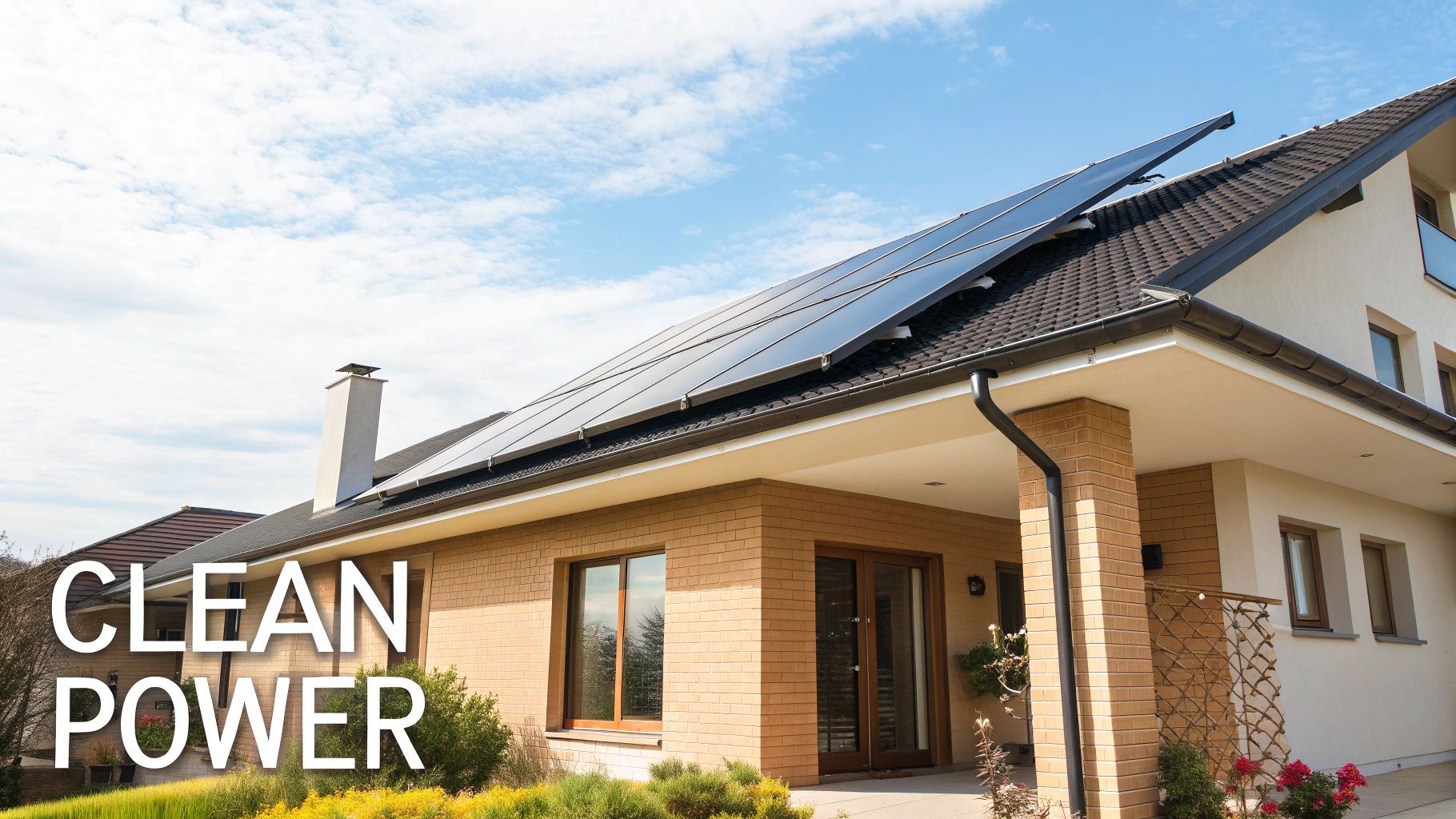
The upfront cost of a solar panel system can give anyone a moment of pause. But it's important to remember you're not just buying a product; you're investing in a complete power-generating plant for your home. That final number on a quote covers much more than just the panels on your roof.
So, what are you actually paying for? The total investment is a bundle of critical components working in harmony. You have the solar panels, of course, which do the heavy lifting of capturing sunlight. Then there’s the inverter, the system's brain, which converts the raw DC electricity from the panels into the AC power your home appliances use. Add in the mounting hardware that anchors everything securely to your roof, and finally, the professional installation costs—which include system design, pulling permits, and all the skilled labor involved.
The Cost Per Watt Metric
When you start getting quotes, you'll want a simple way to compare them. That's where cost per watt comes in. It's the industry-standard yardstick that cuts through the noise.
You get this number by dividing the total system cost by its power capacity in watts. For instance, if a 6,000-watt (6-kilowatt) system costs $16,500, your cost per watt is $2.75. Simple. This single figure helps you make a true apples-to-apples comparison between different proposals, ensuring you’re getting the best value for your money.
If you want to dig deeper into the numbers, our guide on solar panel system installation cost breaks it down even further.
A Typical Residential System Cost Breakdown
Let’s get into the nitty-gritty of where your money goes. While every project is different, this breakdown for a typical 6kW system—a very common size for an average American home—gives you a great picture of the moving parts.
The chart below offers an estimated breakdown, showing how the total investment is split up. It quickly becomes clear that the panels are just one piece of the puzzle.
pie
title Sample Cost Breakdown for a 6kW Solar System
"Solar Panels" : 27.5
"Inverter(s)" : 12.5
"Installation & Labor" : 32.5
"Balance of System (Hardware, Wiring)" : 12.5
"Permitting & Inspection Fees" : 6
Sample Cost Breakdown for a 6kW Solar System
| Component | Average Cost Range ($) | Percentage of Total Cost |
|---|---|---|
| Solar Panels | $4,500 – $6,000 | 25-30% |
| Inverter(s) | $1,800 – $2,500 | 10-15% |
| Installation & Labor | $5,000 – $7,000 | 30-35% |
| Balance of System (Hardware, Wiring) | $1,800 – $2,500 | 10-15% |
| Permitting & Inspection Fees | $900 – $1,500 | 5-7% |
| Total Estimated Cost (Before Incentives) | $14,000 – $19,500 | 100% |
What's the big takeaway here? While the panels get all the attention, they often account for less than a third of the total price. The labor, inverter, and other essential hardware make up the majority of the cost—often more than half the entire project budget. This is why vetting your installer and choosing quality components is just as crucial as picking the right panels.
Calculating Your Solar Payback Period and ROI
After you get a handle on the upfront costs, the big question on every homeowner's mind is, "So, when do I actually start saving money?" This is what we in the industry call the solar payback period. It’s the time it takes for your energy savings to completely cover the initial cost of your system.
Think of it as your break-even point. Once you hit that milestone, every bit of electricity your panels generate is pure, free power. The math to figure this out is surprisingly simple.
The Simple Payback Formula
At its core, calculating your payback period is just a bit of division. You take the final cost of your system—after all the juicy tax credits and rebates—and divide it by what you expect to save on electricity each year.
- Payback Period (in years) = (Total System Cost – Incentives) / Annual Electricity Savings
Let’s walk through a quick example. Say your 7kW system has a price tag of $20,000. The $6,000 federal tax credit brings your net cost down to a much more manageable $14,000. If you're saving $1,500 a year on your utility bills, your payback period comes out to just over 9 years. ($14,000 / $1,500 = 9.33 years).
The chart below breaks down some of the typical costs and savings that go into this calculation.
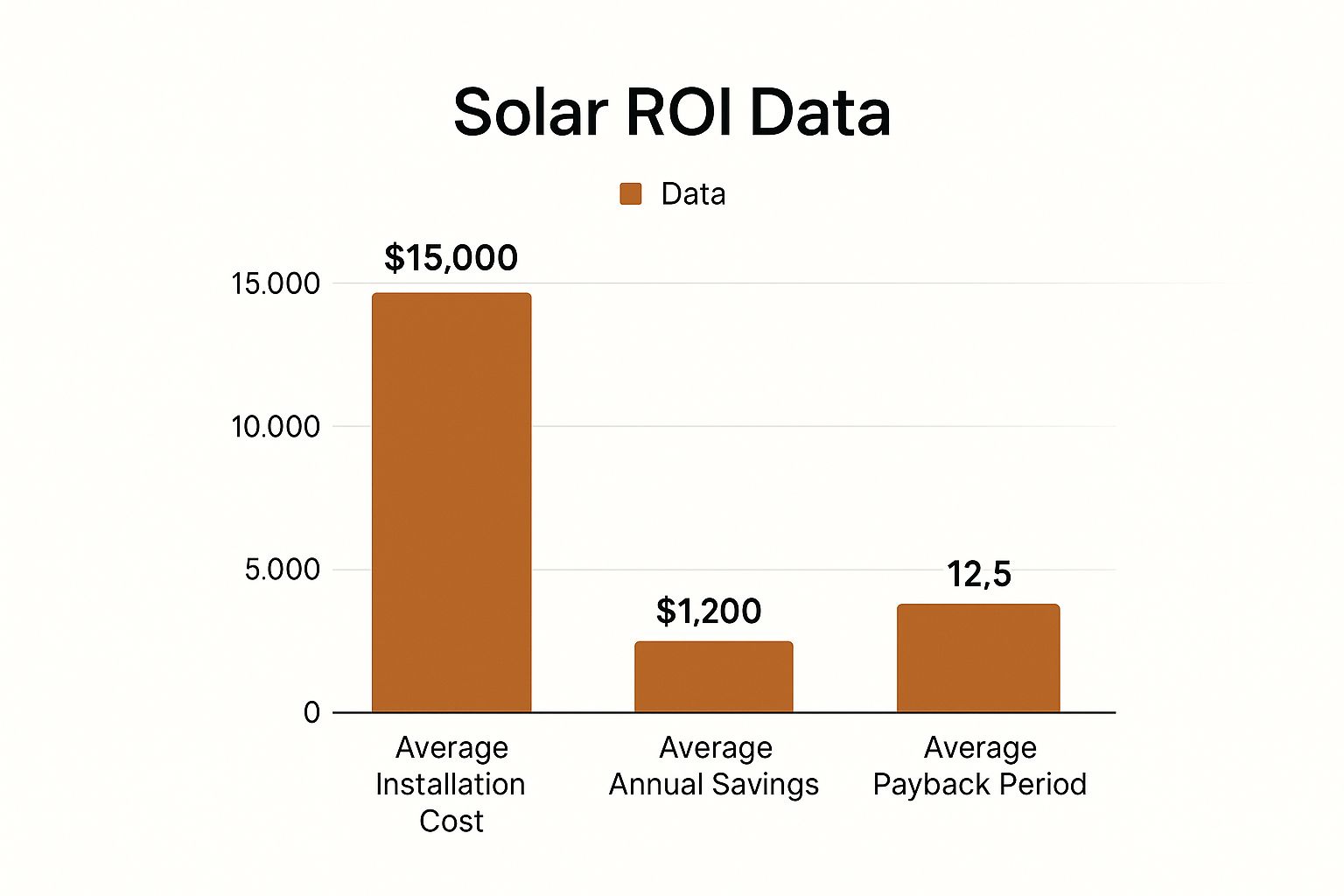
It’s clear that while the initial investment feels substantial, those annual savings really start to add up, making the payback period much shorter than the 25- to 30-year lifespan of the panels themselves.
Visualizing Your Long-Term Savings and ROI
But here’s the thing: the payback period is just the beginning. The real magic happens after you’ve broken even. That's when your Return on Investment (ROI) really takes off, year after year, giving you decades of free electricity.
The true value of a solar investment isn't just breaking even—it's the 20+ years of free energy you get after the payback period is over. This long-term return is what makes solar a powerful financial tool for homeowners.
To get a full picture, it helps to understand realistic solar panel payback periods and all the factors that can influence them. If you want to get a more personalized estimate, a good https://radiantenergysolar.com/solar-return-on-investment-calculator/ will let you plug in your own numbers.
This visual really drives the point home, showing how savings build up over a quarter-century.
---
title: Cumulative Solar Savings vs. Initial Investment
---
gantt
dateFormat YYYY
axisFormat %Y
section Initial Cost & Payback
Initial Investment :crit, done, 2024, 2024
Payback Period :done, 2024, 9.33y
section Long-Term Savings
Free Electricity Period :active, after payback, 15.67y
After that crossover point, your financial gains just keep climbing. That steady growth is exactly why so many homeowners find solar to be such a compelling long-term investment.
How Incentives and Rebates Can Dramatically Cut Your Solar Bill
Let’s be honest, the initial price tag for a full solar installation can be a bit of a shock. But here’s the good news: that number is almost never what you actually end up paying.
Think of it like buying a car with a massive factory rebate, dealer discounts, and a trade-in credit all stacked together. A powerful combination of federal, state, and local incentives can slash your final cost, making the leap to solar much more manageable. These programs exist specifically to get clean energy onto the roofs of homeowners just like you.
The Big One: The Federal Solar Tax Credit
The single most impactful incentive available is the Federal Solar Investment Tax Credit (ITC). This isn't just a simple deduction that lowers your taxable income; it's a true dollar-for-dollar credit against what you owe the IRS.
Right now, the ITC allows you to claim 30% of your total system cost. If your new solar setup costs $20,000, that’s a $6,000 credit that directly reduces your tax bill. It’s a massive discount right off the top, and it’s the cornerstone of making solar affordable nationwide.
But that powerful federal credit is really just the beginning of the savings.
Stacking Your Savings with State and Local Perks
Once you’ve factored in the ITC, the next layer of savings comes from your state and sometimes even your local utility company. This is where things can get really interesting, as the benefits vary wildly depending on where you live. Stacking these local perks on top of the federal credit is the secret to supercharging your return on investment.
Many states sweeten the deal with their own financial incentives:
- Cash Rebates: Some states or utilities will literally cut you a check for going solar. It’s a straightforward cash-back offer, often based on the size of your system, that immediately lowers your out-of-pocket cost.
- Property Tax Exemptions: Worried that a $20,000 home improvement will spike your property taxes? Don't be. Many states have laws specifically exempting solar installations, so you get all the added home value without the bigger tax bill.
- Sales Tax Exemptions: In certain states, you won't pay a dime of sales tax on your solar panels and equipment. That alone can save you hundreds, or even thousands, of dollars right at the point of sale.
These incentives are all designed to tackle the biggest hurdle—the upfront investment—and bring solar within reach for more people.
Getting Paid for the Power You Produce
Beyond the initial discounts, some programs actually pay you for the clean energy your system generates. The most well-known of these are Solar Renewable Energy Certificates (SRECs).
If you live in a state with an SREC market (like New Jersey or Maryland), you earn one certificate for every 1,000 kilowatt-hours (kWh) your system produces. You then sell these certificates to utility companies who need them to meet state-mandated clean energy goals.
This creates a brand new, ongoing income stream straight from your roof. For instance, a homeowner in New Jersey might earn an extra $85 per SREC, effectively turning their solar panels into a small revenue-generating asset.
When you combine the 30% federal tax credit, state rebates, and potential SREC income, you can often shave years off your solar payback period. It’s this powerful stack of incentives that transforms a good long-term investment into a clear and compelling financial win.
Exploring the Benefits Beyond Your Electric Bill

When people ask, "Is solar worth it?", the conversation usually jumps straight to the money. But focusing only on your monthly electric bill misses a huge part of the picture. Going solar is really an investment in a cleaner, more reliable, and self-sufficient way of living.
Generating your own power right on your rooftop has a real, positive impact on the environment. It’s not just an abstract concept; you can actually measure it.
A typical 6kW residential solar system can prevent about 178 tons of carbon dioxide from entering the atmosphere over its 25-year life. To put that in perspective, that's like planting over 4,600 trees or not driving two gas-powered cars for a full decade.
That personal contribution helps shrink your household’s carbon footprint, which means cleaner air and a healthier planet for everyone.
Enhancing Home Value and Energy Independence
On top of the environmental pluses, solar panels are a smart home upgrade that can genuinely pay off when you decide to sell. Research has consistently shown that homes with solar panels don't just sell faster—they sell for more money. Potential buyers see the built-in energy savings as a major perk, giving your property a real edge on the market.
Then there’s the incredible feeling of energy independence. When a storm knocks out the power grid, most people are left in the dark. But if you pair your solar panels with a battery storage system, you've got your own personal power station. Your lights stay on, the fridge keeps humming, and you can keep your phones charged during an outage. That’s a level of security you just can’t get from your utility company.
A Smart Move for Homes and Businesses
And these benefits aren't just for homeowners. Businesses that go solar cut down their electricity costs, sure, but they also get access to great tax incentives and can build a powerful green brand. It gives them a degree of energy security they wouldn't have otherwise.
When you look at it all together, the argument for solar becomes incredibly compelling. It’s not just about saving a few bucks; it's an investment in a more resilient and sustainable future for yourself and your community. For a deeper dive into the numbers, you can find more solar statistics on enkonnsolar.com.
When Solar Panels Might Not Be the Right Fit
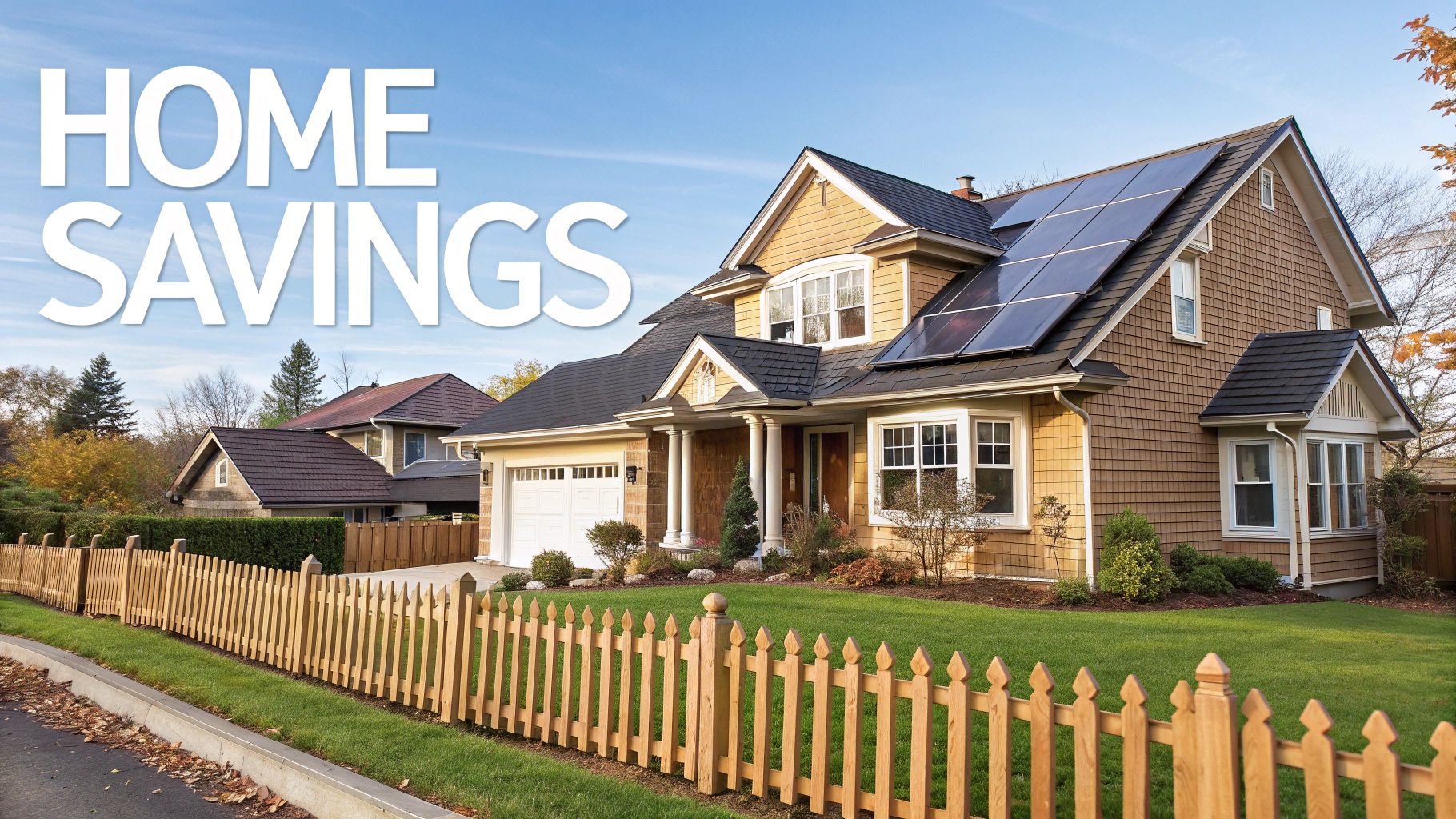
Solar panels can be a fantastic investment for many homeowners, but let's be honest—they aren't a silver bullet for everyone. Answering "is solar energy worth it?" means taking a hard look at when it's just not the right move. Jumping in under the wrong conditions can turn a smart financial decision into a frustrating one with a poor return.
The most common deal-breaker is surprisingly simple: your roof's access to sunlight. If your home is tucked under a canopy of gorgeous, mature trees that cast long shadows all day, your panels will struggle. They crave direct, unobstructed sunlight to do their job effectively.
Key Scenarios Where Solar Might Not Add Up
Your personal timeline is another huge factor. Going solar is a long game, and the payback period often stretches out for several years. If you're planning on moving in the next five years, you probably won't live there long enough to see the full financial benefit through energy savings.
It's crucial to assess your home's solar readiness before committing. An old roof, excessive shade, or short-term living plans can turn a promising investment into a financial setback.
Think about these common roadblocks before you sign on the dotted line:
- You Have an Old or Damaged Roof: Putting brand-new panels on a roof that's on its last legs is a classic mistake. You’ll just end up paying a crew to take the whole system down and put it back up again when it's time for a new roof.
- You Are a Renter: This one is pretty straightforward. If you don't own the property, you can't exactly make a major structural change like bolting a solar array to the roof.
- Your Electricity is Already Very Cheap: If you happen to live in an area with incredibly low utility rates, the savings from solar might feel like a trickle instead of a flood. This can make it tough to justify the significant upfront investment.
- You Live in an Area with Poor Incentives: The financial case for solar often leans heavily on tax credits and local rebates. In places where those perks are thin on the ground, the time it takes to break even can stretch out much longer.
By being realistic about these potential pitfalls, you can make a clear-eyed decision that fits your specific situation and ensures your investment truly works for you.
Your Top Solar Questions, Answered
Even after running the numbers, a few practical questions always seem to pop up. Let's tackle some of the most common things homeowners wonder about before making the switch to solar.
How Long Do Solar Panels Actually Last?
Think of high-quality solar panels as a long-term fixture for your home. Most come with performance warranties that last an impressive 25 to 30 years. They're engineered to be incredibly tough, shrugging off everything from hail and heavy snow to high winds.
While their power output does dip slightly over the years (a process called degradation, usually less than 0.5% annually), they will keep generating clean, free electricity for decades. They’ll continue working hard long after they’ve paid for themselves.
Will Solar Panels Increase My Home Value?
Yes, they absolutely do. Study after study has shown that homes with solar panels sell for more money. It’s a feature that homebuyers instantly recognize as a money-saver.
In fact, research from the National Renewable Energy Laboratory (NREL) found that solar homes not only sold faster but also commanded a higher price. In many cases, the value added to the home is greater than the initial cost of the system, making it a fantastic investment in your property.
What Happens on Cloudy Days or at Night?
This is a classic question. On an overcast day, your panels still work, they just don't produce as much power as they would under a bright, clear sky. At night, of course, they don't generate any power at all.
During these times, your home simply and automatically draws power from the utility grid, exactly like it does now. There's no interruption or flicker.
But this is where adding a battery completely changes the game.
A solar battery is like an energy piggy bank. It stores all the extra electricity your panels generate during the peak sunny hours. You can then use that stored solar power at night or even during a power outage, giving you true energy independence and maximizing your savings. While not essential, a battery unlocks the full potential of going solar.
Ready to see if a solar investment makes sense for your home? The team at Radiant Energy can provide a custom assessment and show you how much you could save. Learn more about our solar solutions at https://radiantenergysolar.com.

